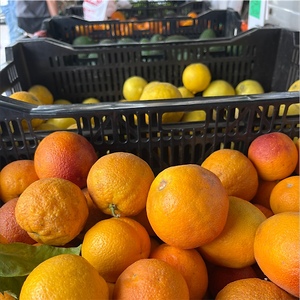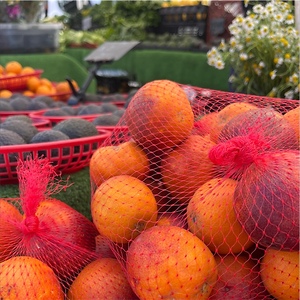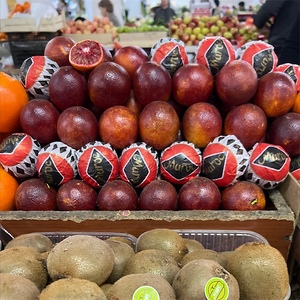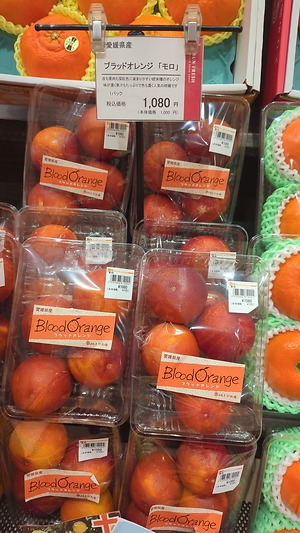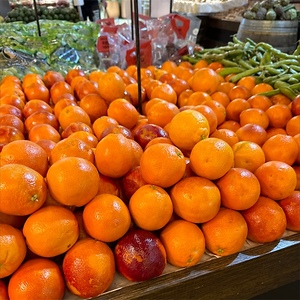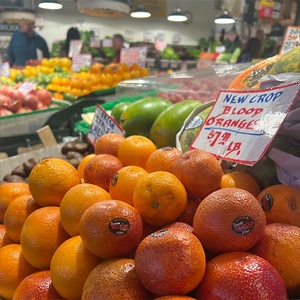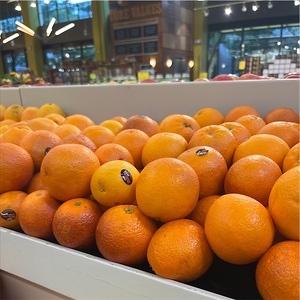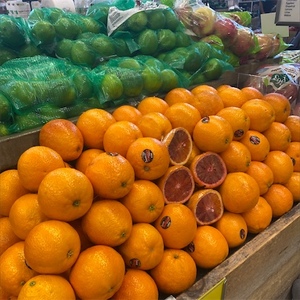


Arnold Blood Oranges
Estimated Inventory, 18 lbs : 0
Description/Taste
Arnold blood oranges vary in size, depending on their growing region, and are generally a small to medium-sized variety with a round to oblate shape. The fruits have a uniform, curved nature, and the rind, also referred to as the skin, is glossy, taut, and firm. Arnold blood oranges ripen to shades of bright orange and dark orange, blushed with deep pigmentation spots. Pigmentation varies per fruit with cultivation conditions, and some fruits may be enveloped entirely in a burgundy blush while others are faintly kissed with red-purple hues. The rind also has a pebbled texture, created from sunken oil glands scattered across the surface, and is somewhat challenging to peel than other orange varieties. Underneath the skin, the flesh is divided into 9 to 11 segments by membranes. The flesh has a deep red to maroon hue and is aqueous, tender, and succulent with a few cream-colored seeds. Like the rind, the flesh varies in color. Arnold blood oranges are edible raw once ripe and release a sweet, floral fragrance when they are opened. The variety is known for its sweet, tangy, and tart taste with berry-like notes reminiscent of strawberries and raspberries.
Seasons/Availability
Arnold blood oranges are grown in Australia and are available from winter through spring. The variety's peak season in Australian markets is July through November.
Current Facts
Arnold blood oranges, botanically classified as Citrus sinensis, are an Australian variety belonging to the Rutaceae or citrus family. The pigmented cultivar is one of the most popular commercial blood oranges in Australia and is a seasonal citrus sold for its distinct colored appearance and sweet and tangy taste. Arnold blood oranges grow on smaller, compact trees and require a specific Mediterranean-like climate to produce colored fruits. The variety is believed to be a sport of the Moro blood orange, which is the most pigmented type grown worldwide. In Australia, Arnold blood oranges are the most reliable cultivar of blood orange to produce pigmented fruits each season. Arnold blood oranges are sought by chefs and home cooks for their saturated, red-purple flesh and juice, and the fruits are consumed fresh or incorporated into a wide array of sweet or savory culinary preparations.
Nutritional Value
Arnold blood oranges have not been extensively studied for their nutritional properties. Blood oranges, in general, are a source of vitamins A and C to maintain healthy organs and strengthen the immune system. Blood oranges also provide fiber to regulate the digestive tract, potassium to balance fluid levels within the body, calcium to support bones and teeth, and other nutrients, including manganese, folate, copper, and iron. The fruit’s pigmented nature is created by the presence of anthocyanins, which are natural compounds with antioxidant properties to reduce inflammation, guard the cells against the damage caused by free radicals, and protect overall bodily health.
Applications
Arnold blood oranges have a sweet and tangy flavor suited for raw and cooked preparations. The variety is popularly pressed into juice and consumed as a fresh beverage. Arnold blood oranges create heavily pigmented juice that can be added to smoothies, cocktails, fruit punches, or sparkling beverages. For flavor and coloring, the juice is added to sauces, syrups, vinaigrettes, and glazes. Try slicing Arnold blood oranges and serving as a decorative garnish on the edge of glasses or layering on fruit and cheese platters for increased visual appeal. Arnold blood oranges can also be added to fruit salads, diced into salsa, slaws, and fresh toppings, or incorporated into parfaits. In addition to raw preparations, Arnold blood oranges are simmered into marmalades, jams, and jellies. The pigmented flesh improves the color of main dishes, especially when served with roasted meats like poultry, duck, and pork, or they can provide a tangy taste to stir-fries. Beyond savory dishes, Arnold blood oranges are used in fillings or sliced as a garnish over desserts like cakes, tiramisu, and tarts. They can also be added to sorbets, ice cream, and gelato. Arnold blood oranges pair well with other fruits like lemons, bananas, mangoes, and berries, herbs including tarragon, mint, and basil, fennel, watercress, and chocolate. Whole, unopened fruits will keep for a few days when stored at room temperature and for 1 to 2 weeks when placed in the refrigerator.
Ethnic/Cultural Info
Arnold blood oranges were named after Mike Arnold, a grower based in Waikerie, a town in the Riverland region of South Australia. Mr. Arnold was inspired to grow blood oranges after several research trips to the Mediterranean, where he visited citrus farms in Italy. After his travels, he removed wine grapes from his land and planted blood oranges as a specialized crop to differentiate his fruits in Australian markets. The blood oranges were a success and are still among Australia's most recognized varieties. Mike Arnold was also inducted into the Citrus Australia Hall of Fame in 2023 in honor of his contributions to the citrus industry. Throughout his career, Mr. Arnold was the Chair of the Australian Citrus Improvement Association and was also a founding member of the South Australian Citrus Improvement Society. He remained active throughout these groups for many years and advocated for citrus growers. Mr. Arnold was inducted into the Hall of Fame at the Citrus Australia Market Outlook Forum Conference.
Geography/History
Arnold blood oranges are native to Southern Australia and were developed in the town of Waikerie. The variety is thought to be a sport of the Moro blood orange and was created through natural selection by citrus grower Mike Arnold. Since its release to commercial markets, Arnold blood oranges have become one of Australia's most popular blood orange varieties. The variety is primarily sold through domestic markets as a fresh fruit and occasionally exported to Europe on a small scale. Today, Arnold blood oranges are cultivated in regions with Mediterranean climates in South Australia and New South Wales. The variety thrives in coastal groves and develops the most pigmentation when it experiences hot days and cold nights. When in season, Arnold blood oranges are sold directly through growers, farmers’ markets, supermarkets, and retailers in Australia.
Recipe Ideas
Recipes that include Arnold Blood Oranges. One



